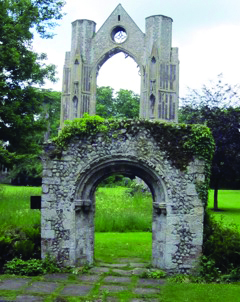Many religions feature pilgrimage as an aspect of practicing the faith. For example, one of the “five pillars of Islam” is to make the “haj,” a ritual visit to Mecca, once during one’s lifetime. In Christianity, pilgrimage has been called a “symbol in action,” representing the journey of the Christian’s life from earth to heaven.
Most readers today are familiar with England’s most popular Medieval pilgrimage destination through Geoffrey Chaucer’s “The Canterbury Tales,” which tells the story of a group of travelers journeying from London to Canterbury Cathedral to worship at the shrine of the martyred Archbishop St. Thomas a Becket. However, there was an equally popular pilgrimage destination located several day’s journey northeast of London in a tiny village just five miles from the North Sea coast. Medieval pilgrims traveled here to honor Our Lady of Walsingham.
According to tradition, in 1061 a Saxon noblewoman named Richeldis had a vision in which she was taken by the Virgin Mary to the house in Nazareth where the Archangel Gabriel had asked her to become the Mother of Jesus. Mary asked Richeldis to build an exact replica of that house in Walsingham.
This became known as the Holy House, and pilgrims flocked to visit it for centuries. Soon a large abbey was built around the shrine. Several English kings and queens visited the shrine and richly endowed the abbey, making it one of the wealthiest in the country.
In the 16th century, during England’s Reformation, the monasteries were “dissolved.” In 1538, the Walsingham shrine and abbey were destroyed and anything of value sold or given to King Henry VIII’s supporters.
After four centuries, there was a return of pilgrimages to Walsingham. In 1897, the Roman Catholic Church restored the Slipper Chapel, a small church where medieval pilgrims removed their shoes before walking the last mile to the shrine. It has become the National Shrine of Our Lady of Walsingham.
In 1921, the Anglican vicar of the village church began to encourage pilgrimages to the location of the traditional site of the shrine. By 1931, a new Holy House was built based on dimensions of the old one, a new statue of Our Lady was dedicated, and begun work on an Anglican Shrine dedicated to Our Lady of Walsingham.
Father Alfred Hope Patton was part of the Anglo-Catholic tradition of the Church of England. He believed in the continuity between the Pre-Reformation Church and the C of E in his own day, which is reflected in the shrine’s use of icons, statues, incense, and reverence to the Virgin Mary and other saints.
As pilgrims have continued to visit this isolated but picturesque location in increasing numbers, there have been improvements in the facilities:
– 15 chapels
– A holy well whose water is used to sprinkle pilgrims for healing
– Carefully preserved holy relics
– An amphitheater with an outdoor altar dedicated to the Mysteries of the Rosary
– Guest rooms for pilgrims and people on retreat
– Café and gift shop.
Close by the shrine is the ruins of Walsingham Abbey. Several arches and walls from the 11th century building are still standing, and the adjacent museum contains a collection of objects and photographs telling the history of this remarkable place of pilgrimage.
While in London recently I discovered there is no convenient public transit to Walsingham. Since I am averse to driving on the left side of the road, I decided to take a train from Kings Cross station to Kings Lynn in Norfolk. Instead of continuing on two local buses, I chose to take a taxi that allowed me a chance to see Sandringham, the Queen’s country estate, on my return trip.










